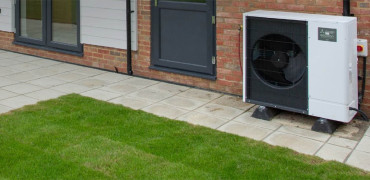We have recently published a guide on heating efficiency in air and water source heat pump systems to increase understanding on application and design of these systems.
Calculating efficiency in a heat pump is complex as there are many variables which will impact performance.
That is why there are detailed testing standards which set out which tests must be carried out and at what operating conditions. These standards also specify the calculation methodology to derive performance across an entire heating season and provide a platform to compare different products against each other.
Understanding exactly how these tests and calculations are carried out will allow heat pump system designers and other built environment professionals to better use manufacturer published performance data and relate it to individual projects.
The guide looks at overarching legislation and testing standards for heat pump efficiency
Legislation
The guide looks at the legislation dictating the minimum efficiency level that a heat pump must reach as well as how that efficiency is measured, calculated and reported by manufacturers. It also looks at why certain data is available or not available for different products and why all data from manufacturers is shown in a particular format with specific references & caveats
The guide gives a brief description of the overarching legislation covering minimum heat pump efficiencies which is known as the ErP directive (Energy-related Products).
It also dives into testing standards looking at two in particular – EN14511 (Performance at specific conditions) and EN14825 (Performance across the heating season) which covers climate profiles and heating loads based on cold, average and warm zones of Europe.
The UK broadly falls into the average climate profile which defines the minimum and maximum ambient temperatures of the heating season as -10ºC and +15ºC respectively with a total of 4910 hours spent in heating mode.
Seasonal performance
With both climate and load profiles specified, EN14825 then goes on to provide the option of four different tests to demonstrate product seasonal performance across an annual heating season at different water flow temperatures - these are referred to as;
- Low = 35°C
- Intermediate = 45°C
- Medium = 55°C
- High = 65°C
Each of these tests allows for either fixed water flow temperature across the year or for a variable (weather compensated) flow temperature to be used.
In Summary
The guide will prove useful to system designers and installers needing to calculate the seasonal performance of heat pumps taking many different factors of testing into consideration.
Most of these factors can significantly affect the outcome of the calculation, and therefore have a major impact on the ongoing performance of the heat pumps.
These include: the duration of the test; the temperature of the water, the air temperature; the climate and the load profile; the water pump; the electrical energy; and the controls.
It is also worth understanding that project specific design conditions are unlikely to be similar to standard test conditions and therefore reported seasonal efficiency may not be an accurate representation of product performance. However, it remains the most accurate way to standardise testing and allow for generic comparisons.
Some of the factors that often differ significantly are;
Flow temperature - only 4 flow temperatures are available which might not match project specific design flow temperature
Weather Compensation - project specific flow temperature adjustment is unlikely to match the assumptions
Climate Profile - the temperatures experienced and for how many hours per annum is not likely to match project specific estimations due to significantly different climate around the UK
WSHP Source temperatures - WSHP source temps are unlikely to match standard test assumptions which will disproportionately affect seasonal efficiency
Hydraulic arrangement - different configurations such as fixed or variable water flow rates, separate primary and secondary circuits, thermal storage etc. will impact overall system efficiency
Control logic - dynamic operation under part load conditions, sequencing of multiple units operating in parallel and control of ΔT will affect overall performance
By understanding the differences between test conditions/assumptions and project specific conditions, designers can make more informed decisions on how best to use manufacturer published efficiencies on individual projects to help bridge the performance gap or better represent likely equipment operational energy usage.
You are welcome to download the full guide.
Chris Newman is Zero Carbon Design Manager- Mitsubishi Electric




